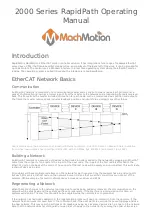
1
1. INTRODUCTION
1.1 Theory of Operation
Earth Pressure Cells, sometimes called Total Pressure Cells or Total Stress Cells are designed to
measure stresses in soil or the pressure of soil on structures. Cells will respond not only to soil
pressures but also to ground water pressures or to pore water pressure, hence the term total
pressure or total stress. A simultaneous measurement of pore water pressure (
µ
), using a
piezometer, is necessary to separate the effective stress (
σ
') from the total stress (
σ
) as defined by
Terzaghi's principle of effective stress:
σ
'
=
σ
-
µ
Equation 1 - Terzaghi’s Principle of Effective Stress
These parameters coupled with the soil strength characteristics will determine soil behavior
under loads.
Earth pressure cells of the type described here are the hydraulic type; two flat plates are welded
together at their periphery and are separated by a small gap filled with a hydraulic fluid. The
earth pressure acts to squeeze the two plates together thus building up a pressure inside the fluid.
If the plates are flexible enough (i.e., if they are thin enough relative to their lateral extent), then
at the center of the plate the supporting effect of the welded periphery is negligible and it can be
stated that at the center of the cell the external soil pressure is exactly balanced by the internal
fluid pressure.
This is true only if the deflection of the plates is kept to a minimum and thus it is important that
the cell be stiff. This in a practical sense means that the fluid inside the cell should be as
incompressible as possible and that the pressure transducer required to measure the fluid pressure
should also be stiff having very little volume change under increasing pressure.
Tests conducted by various researchers (as reported by Dunnicliff, 1988) have shown that the
introduction of a flat stress cell into a soil mass will alter the stress field in a way dependent on
the relative stiffness of the cell, with respect to the soil, and also with respect to the aspect ratio
of the cell, i.e., the ratio of the width of the cell to its thickness. A thick cell will alter the stress
more than a thin cell. For these reasons, a thin, stiff cell is best and studies have shown an aspect
ratio of at least 20 to 1 to be desirable.
Ideally, the cell ought to be as stiff (compressible) as the soil, but in practice this is difficult to
achieve. If the cell is stiffer (less compressible) than the soil then it will over register the soil
pressure because of a zone of soil immediately around the cell which is "sheltered" by the cell
and therefore does not experience the full soil pressure. This can be represented schematically as
shown in Figure 1.








































